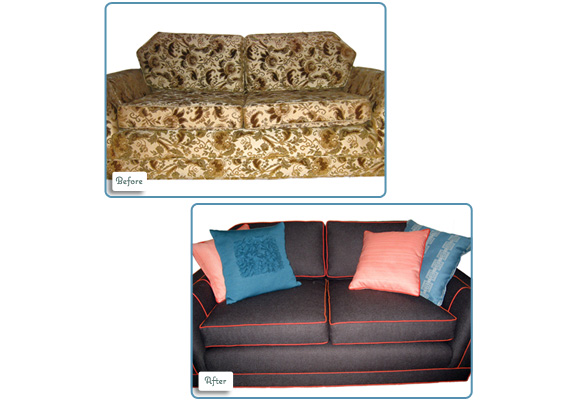Turning Oldies into Goodies: Eco Couch Upholstery
Date: November 16, 2009 | Category: Home Furnishings, Stores & Resources, The Home

By ecofabulous founder, Zem Joaquin. Presented by The eBay Green Team.
This past summer Ecofabulous designed the interior of the Reclaimed Space showhouse at Dwell on Design. Since the cottage was diminutive, everything had to be scaled down and easy to move. When we were sketching out the space I instantly thought of my grandmother’s couch from the 1940’s (I’ve been coveting it for over 20 years). It took some puppy dog eyes to convince grandma and some imagination to make it work with the rest of the decoration, but the process was well worth the end result.
Opting for older seating means you’ll make less of an impact on the environment by reducing the amount of new resources used and saving quality items from ending up in the landfill. Plus, buying vintage contributes to better indoor air quality since new items are often fraught with chemicals that will have already off-gassed by the time the pre-owned piece ends up in your hands. And if it needs a facelift, you can select healthy options! But reupholstery is an investment, so you’ll want to get it right the first time in order make sure you love it for it’s (new) lifetime.
Here is a cheat sheet of eco-guidance when getting anything professionally reupholstered:
| Source Locally to Minimize the Carbon Footprint Sourcing labor and materials as locally as possible reduces your item’s transportation, and therefore the amount of carbon emissions associated with the project. If you’re purchasing off Kijiji, the local classifieds site makes it easy to find items in your area, but did you know that there’s an option on eBay.com to sort search results by zip code? Look for the “Distance” box on the lower left-hand side. This also helps to reduce on shipping costs since many items are available for local pick-up! |
|
| Assessing Seating - Make Sure You’ve Got Good Bones
Before you decide to invest in the makeover of a previously-owned piece, ask yourself if the overall structure and frame of the item is something you’ll be happy with for many years to come. Make sure you love the shape and style, because, regardless of changes in minor decor items, a foundation piece like a couch should stand the test of time.
Additionally, assess for water damage and anything else that would compromise the structural integrity of the piece. If searching on Kijiji, you’ll likely be able to view your desired item in person. If ordering on eBay, take a close look at the images provided and feel free to send the seller a message if any blemishes or spots look questionable - sometimes you can even arrange to check out the piece for yourself.
|
|
| Choose an Eco-Friendly Fill If the old cushion or stuffing from the existing couch is in decent condition, then chances are that the chemicals have stopped off-gassing and it’ll be much more affordable to keep the original fill. However, if the material is lumpy or the foam is crumbling, it’s best to get new fill if you want the couch to last your lifetime. Make sure to select an eco-friendly option (and there are plenty!) in order to ensure you aren’t exposing yourself and/or the environment to harsh chemicals. Most conventional cushions are made with synthetic foam, which can off-gas in your home and contribute to poor indoor air quality. Here are a few of the most popular natural fill choices; make sure your upholster carries them! 1. Organic Cotton - grown without pesticides, herbicides or insecticides. Often most cost-effective eco-option. 2. Organic Wool - a great choice since wool is renewable (the sheep grow a new coat each shearing), is naturally fire retardant and resistant to dust mites. Organic means that the sheep were not exposed to “cides” at any point in production. 3. Natural Tapped Rubber - the firmest, bounciest selection. Latex is tapped from a rapidly renewable rubber tree (think maple syrup). It heals itself within an hour each time! It is also biodegradable, but don’t worry, it has to be under the right conditions… hidden inside a sofa isn’t the right condition. |
|
| Choose an Eco-Friendly Fabric There are SO many options for sustainable fabrics on the market, it’s thrilling. For upholstery purposes I like to stick with recycled polyester or organic wool if the piece is going to be heavily trafficked (like 2 children jumping on it). Recycled polyester, or rPET, is made from old plastic bottles; it’s very durable; and comes in an enormous array of colors and patterns. I love Valley Forge’s FRESH Collection (that’s the orange piping I chose), Victor Innovex and Designtex. Q Collection has an extensive offering of sustainable fabrics like alpaca, hemp, linen, wool and organic cotton (I used their Heather fabric above). O Ecotextiles and LIVE Textiles have stunning alternative fabrics as well! For fun, modern, organic cotton prints (great for lesser trafficked pieces and pillows), I use Rubie Green and Mod Green Pod. I chose Rubie Green’s Mary style in Natural for my recent telephone bench makeover. |
|
| Decorate with Pillows! Complete the transformation with some stylish throw pillows. Look for pillows filled with organic cotton, organic wool, buckwheat hulls or kapok (a super soft fiber made from the seed pod of the kapok tree), and covered in a sustainable fabric. Some of my ecofabulous favorites are LoooLo, Humble Collection, Spruce Design, and Ortolan. Or order fabric from any of the companies listed above and make your own! |









Comments
sheri
Date: November 16th, 2009 at 2:21 pm
Q collection has gorgeous fabrics! I am dreaming of how to use them in my home remodeling!
Comment on this story
Comments are moderated, and will not appear on this weblog until approved.